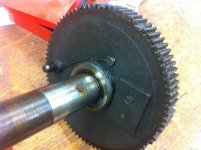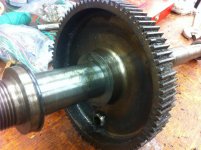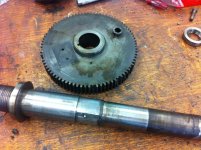RCP Designs:
I am glad the technique of "judicious heating" worked for you. I am also glad you got the bull gear off the spindle without damaging anything in the process. Old machine tool parts are kind of like "unobtainium" when dealing with castings. A little rust can stick things together better than the strongest Loctite. A little heat to break a bind and loosen a tight fit even a very small amount can work wonders. I tend to follow the old Hippocratic oath when it comes to working on machinery: "Do no harm". I also take the view that if one man designed it and others built it and put it together, it can come apart (unless it is welded soldily or driven hard and peened over or similarly locked together). I look for clues, study things, and often will spend more time making the correct tools to take something apart than doing the actual job. Years ago, on a turbine job, I learned that even the most massive of machined parts are precisely fit and not meant to be forced. I also learned from being "on the sidelines" as an engineer, when a millwright apprentice swung wild with a sledge and nailed a turbine shaft journal, that one misplaced blow of a sledge could result in several weeks delay, and quite a sum of money to put things right. The result is I tend to think and look and investigate and then think and look some more before I go taking any major steps like attempting to press off a hub from a shaft. As I said, my belief is what men designed, built and put together, other men can figure out, take apart, work on, and put to rights.
When you go to put the bull gear back on, my advice is to stone the spindle to knock down any slight burrs, particularly around the keyway. Clean out the keyway, and clean up the key, and check the fit. It should be snug in the keyways of the spindle and bullgear hub. I like to warm or heat things like bull gears in a pot of turbine oil, getting them to maybe 180-200 degrees F. Turbine oil in an old pot, with the bull gear up on a piece of channel steel to keep it off the bottom of the pot, is how I'd do it. Turbine oil (Tractor Hydraulic oil, ISO 46) is plenty good for the purpose. When the gear oil reaches 180-200 degrees F, let the gear soak in it for 30 minutes, so it is heated through. A camp stove or hotplate is what works for heating the oil. Or, if you are able to do it, place the bullgear in the oven in your kitchen and get it up to 200 degrees F and keep it there for 30-45 minutes. The growth on the gear may well be enough for it to drop right onto the spindle where it belongs, no pressing needed. You can also put the spindle into the freezer for an hour or so prior to fitting on the bull gear, but it will "frost up" when you take it out of the freezer. When this happens, I douse the cold part with alcohol to get rid of the frost. I've done bull gears on Southbend lathes in this way, no need of a press.
When you put the bull gear back onto the spindle after repairs, lubrication on the spindle and gear hub's bore and keyway is important. Some turbine oil is fine. I'd be hesitant to use something like "Dry Slide" or Moly disulfide compounds, since those can wind up in the lathe's spindle and cone pulley bearings.
I'm glad things worked for you. Oldtimers taught me tricks like this along the way, and I remembered them. This one time, we had to take a Falk gear-tooth coupling hub off a 10" diameter shaft. The mechanics assigned to the job were not the sharpest men in the crew, and one man was plainly a bull. Plenty willing, but not too sharp, and was going to do it his way. I told them: "get your puller set and take a light strain" (this was a porta power puller with about a 30 ton ram in it). "Once you have the puller set, take your rosebud and heat the portion of the hub where the keyway is, and when your spit sizzles on that part of the hub, pump on the porta power and give the hub a few raps with a bronze hammer..." I expected they'd have the hub pulled before morning break. By lunchtime, word reached me they were getting nowhere. By quitting time, they had run out of oxygen for the torch. I came up there the next morning, and the hub and shaft were black with scale on the hub from excessive heating. I asked the mechanics what they'd done and got the answer I expected: "Heated the s---t out of it, and it would not budge..." I told them to give me some soapstone, and I marked where the keyway was in the hub. I then told them: light the rosebud and get a nice medium flame on it, not a roaring flamethrower. Put the heat where I marked and NOWHERE else. I told them when to pull back with the rosebud, and spat on the hub at the soapstone marks. A bit more heat and my spit sizzled and danced. I told them to pump on the porta power puller and hit the hub with hammers. "Bang" went the hub and it came off the shaft easily. Of course, with as much heat put into that Falk gear tooth coupling hub as those two bulls had put into the previous day, the coupling hub was junk. The two bulls were amazed and then mad at me. Telling me I had some "trick" or something to that effect. I told them I had only done what I had described to them the previous morning, and they'd wasted a full day and f--d up a coupling hub which was going to cost time and money to replace- we'd get a new hub, have to bore it and cut in a keyway, to say nothing of their own time. Most of the mechanics knew if I told them something, it usually had some basis in fact and would work, but this one guy was just a bull, physically and mentally, and there was no telling him anything. The trick was to assign him to work where he could kill himself and not mess anything up, where a bull was needed. Sometimes, he got assigned to jobs requiring a little brain work, and then it was a question of who his partner was and whether he'd listen to his partner- who often was the one to ask me about the jobs. We have the most incredible gifts in our minds, senses and our physical bodies, and this kind of work gives us opportunity to use those gifts to figure stuff out and then do the actual work. It is a reward I never tire of, even after well over 40 years at this kind of work.






